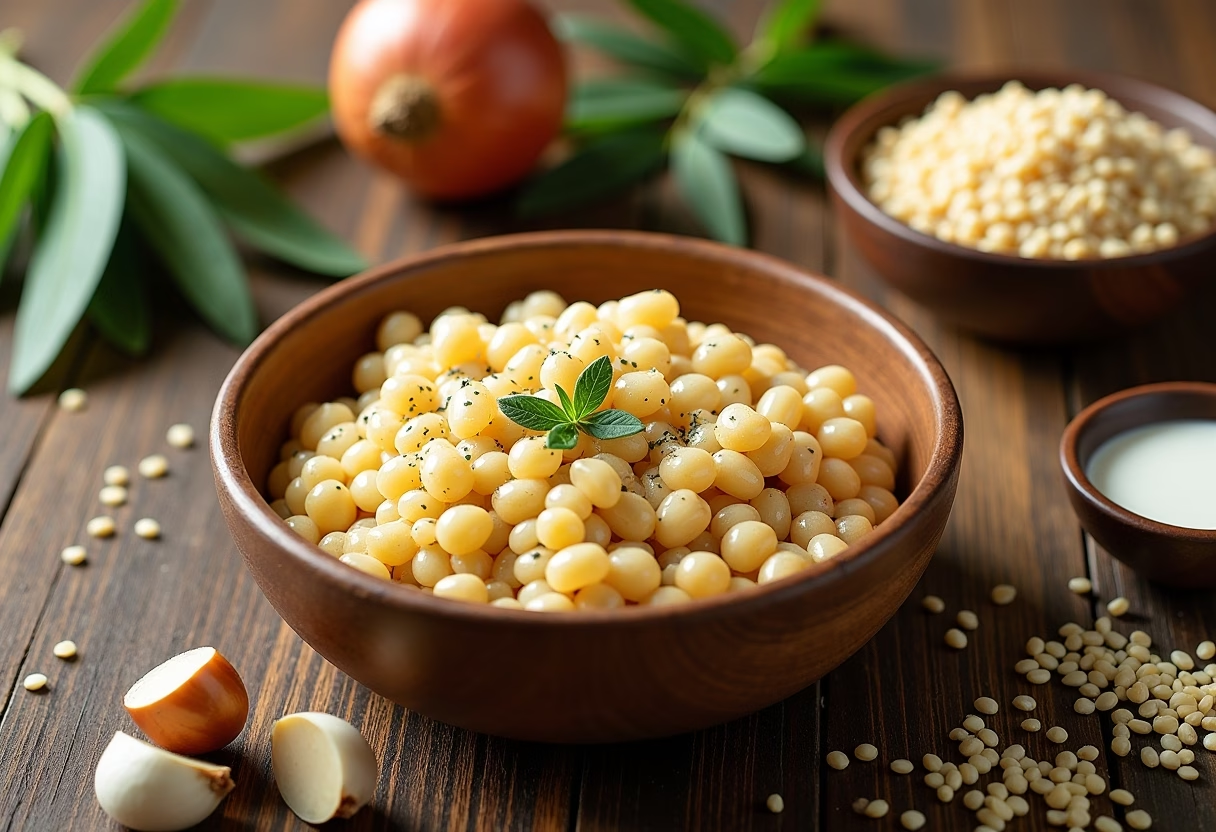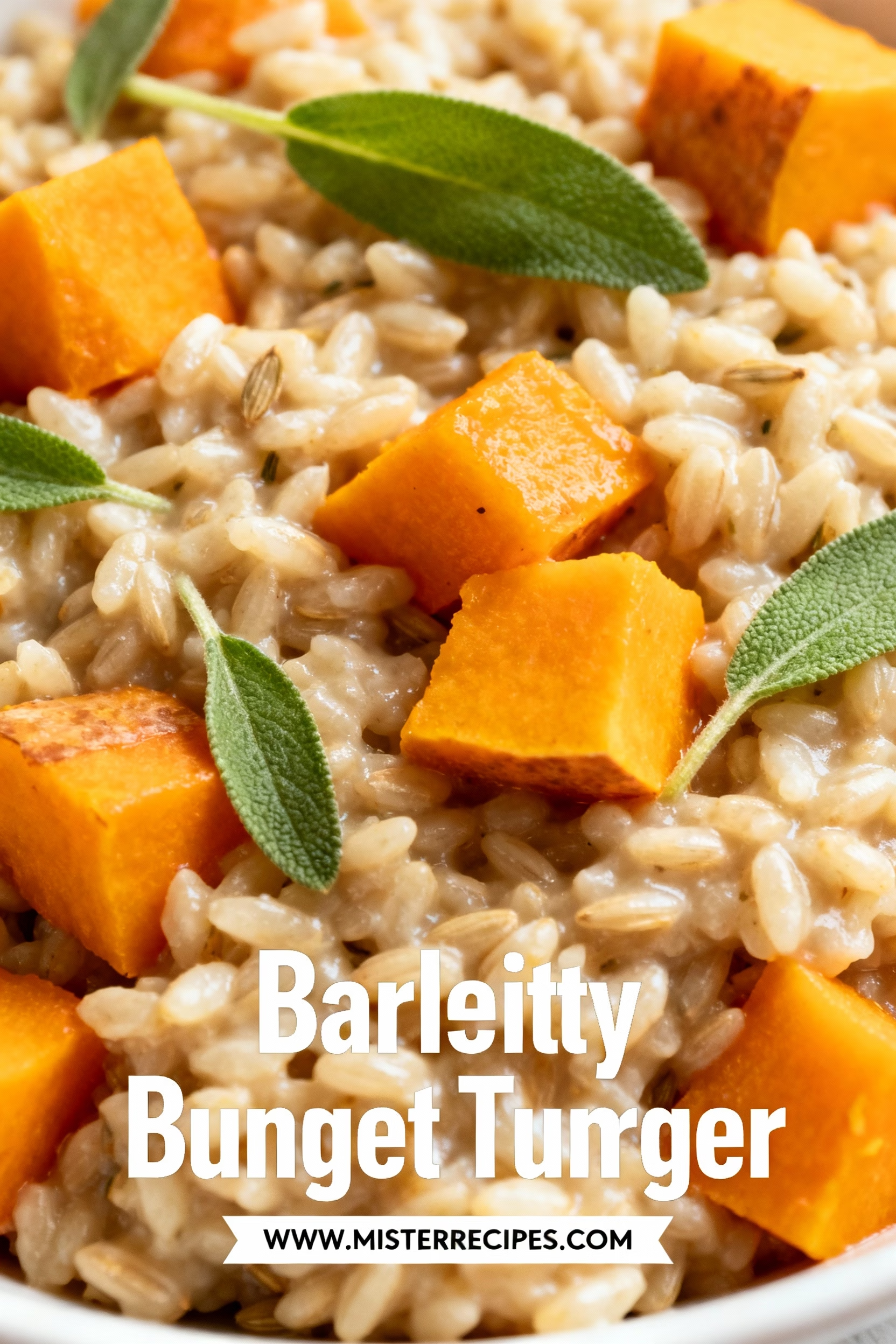There’s a certain slant of light that only happens in a Minneapolis autumn. It’s golden and low, stretching long shadows across the kitchen floor where just a few months ago, the sun was high and unforgiving. That light smells like something, too. It smells like damp leaves, woodsmoke from a distant chimney, and the promise of cozier days. It always makes me want to slow down, to pull out the heavy Dutch oven that spends its summers in quiet hibernation. Have you ever wondered if comfort food is less a category of dishes and more a response to the season’s call for warmth? This Barley Risotto with Butternut Squash & Sage is my answer to that call. It’s a dish that feels like pulling on your favorite well worn sweater.
I didn’t grow up with risotto. In my Midwestern home, with its quiet echoes of Eastern European practicality, the comfort grains were different. My grandmother taught me the humble magic of barley, a grain she’d stir into soups to make them last, to add a hearty, toothsome chew that felt like true nourishment. It wasn’t fancy, but it was honest. Years later, when I first learned the classic Italian stirring risotto technique, that patient, rhythmic motion of coaxing creaminess from rice, I felt a familiar sense of peace. It was the same slow dance my grandmother did with her soup pot. So, I wondered, what if I combined the two? What if I took the elegant method of risotto and applied it to the humble, nutty and wholesome grain of my childhood? The result is this homemade barley risotto with squash, a dish that holds the memory of my grandmother’s kitchen and the sophistication of a meal I love to make for my own family today. It’s a bridge between worlds, a bowl of edible sunshine on a cool autumn day, a truly hearty vegetarian meal that feels both nostalgic and new.
Why You’ll Love This Barley Risotto with Butternut Squash & Sage
This isn’t just a recipe; it’s a feeling. It’s the perfect project for a lazy Sunday afternoon when you want the house to fill with the most incredible aromas. Every time I make this fall barley risotto recipe, my husband Jonah wanders into the kitchen, camera in hand, drawn by the scent of toasting barley and sizzling sage. The kids, who usually wrinkle their noses at squash, are won over by the luxuriously creamy texture and the sweet, caramelized flavor. Here’s why I know this dish will become a treasured part of your autumn cooking rotation:
A Celebration of Fall Flavors in Every Bite. This dish is the very essence of the harvest season. The butternut squash recipes we all love peak in autumn, and here, roasting the squash first coaxes out its deep, sweet, and nutty character. This sweetness is perfectly balanced by the woodsy, earthy notes of fresh sage. The barley itself acts as a beautiful canvas, with a slightly nutty flavor that ties everything together. It’s the kind of meal that makes you want to light a few candles and gather around the table, a perfect centerpiece for any harvest dinner recipes collection.
Creamy, Cozy, and Deceptively Simple. People are often intimidated by risotto, imagining hours of non stop stirring. But the creamy risotto secret here lies in two things: the choice of grain and a patient method. Pearl barley naturally releases starches as it cooks, creating a creamy sauce with less effort than traditional Arborio rice. The stirring risotto technique is more about gentle, consistent encouragement than a frantic workout. You add a ladle of warm broth, stir until it’s mostly absorbed, and repeat. It’s a rhythm, a meditation. It’s a beginner barley risotto in disguise, delivering a five star texture that tastes like it was much harder to achieve. Plus, it’s a stunning one pot barley risotto (besides the pan for roasting the squash), which makes cleanup a breeze.
Wholesome, Hearty, and Deeply Satisfying. Unlike its rice counterpart, barley risotto offers a wonderful, slightly chewy texture that makes the dish feel substantial and grounding. Barley is a fantastic risotto alternative grain, packed with fiber and nutrients, turning what could be a simple side into a complete and healthy fall vegetarian recipe. It fills you up without weighing you down. On nights when we need something that feels both nourishing and indulgent, this is the recipe I turn to. It’s proof that vegetarian comfort food can be the most satisfying meal of the week.
Endlessly Adaptable to Your Kitchen. This recipe is a roadmap, not a rigid decree. Think of it as a starting point for your own culinary stories. You can use different types of barley for risotto, though I find pearl works best for creaminess. Don’t have butternut squash? Acorn or delicata squash would be wonderful. No fresh sage? A pinch of dried will work. I’ve even swirled in a spoonful of goat cheese at the end for extra tang. I encourage you to explore our guide to creamy butternut squash soup to see how versatile this star ingredient can be. You can create your own version of this vegetarian barley risotto butternut squash that speaks to what you have on hand and what your family loves.
Ingredients for Barley Risotto with Butternut Squash & Sage
- 1 small (about 2 lbs) butternut squash, peeled, seeded, and cut into ½ inch cubes
- 2 tablespoons olive oil, divided
- Salt and freshly ground black pepper
- 6 cups vegetable stock risotto or chicken broth, kept warm in a saucepan
- 2 tablespoons unsalted butter
- 1 large shallot, finely chopped (about ½ cup) (or one small yellow onion)
- 2 cloves garlic, minced
- 1 ½ cups pearl barley, rinsed
- ½ cup dry white wine, like Sauvignon Blanc or Pinot Grigio (optional, can substitute with more broth)
- ¼ cup chopped fresh sage, plus a few whole leaves for garnish
- ½ cup freshly grated Parmesan cheese risotto, plus more for serving
- 1 tablespoon fresh lemon juice (optional, for brightness)

How to Make Barley Risotto with Butternut Squash & Sage
Step-by-Step Instructions
Making this creamy barley risotto butternut sage is a process of slow, rewarding transformation. Put on some music, pour yourself a glass of that white wine, and enjoy the rhythm of the kitchen. This is where simple ingredients become something truly special.
Roast the Butternut Squash: Preheat your oven to 400°F (200°C). On a baking sheet, toss the cubed butternut squash with 1 tablespoon of olive oil, a generous pinch of salt, and a few grinds of black pepper. Spread it in a single layer and roast for 20 to 25 minutes, or until tender and lightly caramelized at the edges. The kitchen will start to smell sweet and toasty; this is the first layer of flavor. Once done, set it aside. This is the simplest method for how to cook butternut squash for maximum flavor.
Prepare Your Mise en Place: While the squash roasts, this is the time to get everything else ready. Pour your vegetable stock into a small saucepan and set it over low heat. Keeping the broth warm is crucial; adding cold liquid to the hot pan can shock the grain and hinder that beautifully creamy texture. Chop your shallot, mince your garlic, and measure out your barley and wine. Having everything ready makes the stirring process calm and enjoyable.
Sauté the Aromatics: In a large, heavy bottomed pot or Dutch oven, melt the butter with the remaining 1 tablespoon of olive oil over medium heat. Add the chopped shallot and a pinch of salt. Cook, stirring occasionally, for about 3 to 4 minutes, until the shallot is soft and translucent. Add the minced garlic and cook for another minute until fragrant. Be careful not to let the garlic brown.
Toast the Barley: Add the rinsed pearl barley to the pot. Stir continuously for about 2 minutes. You’ll hear it making a soft, crackling sound, and it will become fragrant with a nutty aroma. This little step is so important; toasting the grain enhances its flavor and helps it cook more evenly.
Deglaze the Pan: Pour in the white wine (if using). It will sizzle and steam as it hits the hot pan. Stir constantly, scraping up any delicious browned bits from the bottom of the pot. Continue to cook until the wine has almost completely evaporated. That sharp smell of alcohol will cook off, leaving behind a subtle acidity and depth.
Begin the Risotto Rhythm: Now for the meditative part. Add one large ladleful (about 1 cup) of the warm vegetable stock to the barley. Stir until the liquid is almost completely absorbed. The barley will look creamy and the mixture will be thick. Continue adding the broth, one ladleful at a time, letting each addition be almost fully absorbed before adding the next. Stir frequently but not frantically. This gradual process allows the barley to release its starches, which is what creates the signature creamy sauce. The total risotto cooking time barley will be about 35 to 45 minutes.
Check for Doneness: After about 35 minutes, start tasting the barley. You’re looking for a texture that is tender but still has a pleasant, toothy chew, or what the Italians call al dente. It shouldn’t be mushy. If you run out of broth and the barley still isn’t cooked to your liking, you can add a little hot water. For a different take on risotto texture, you can explore another delicious butternut squash risotto recipe that uses classic Arborio rice.
Finish the Dish: Once the barley is cooked perfectly, turn off the heat. Gently stir in the roasted butternut squash, the chopped fresh sage, and the grated Parmesan cheese. The cheese will melt into the risotto, making it even more luxuriously creamy. If the risotto seems a bit too thick, stir in another splash of warm broth to reach your desired consistency. Finally, stir in the fresh lemon juice, if using. I find it brightens all the flavors beautifully. Taste and adjust with more salt and pepper if needed. Let it rest for a minute before serving.
Pro Tips & Variations
Over the years of making this dish, I’ve gathered a few little secrets that ensure it turns out perfectly every time. This recipe is also a wonderful starting point for your own creative twists. Think of these as friendly suggestions from my kitchen to yours.
Warm Broth is Non Negotiable. I mentioned it in the steps, but it bears repeating because it’s the most important tip for a creamy risotto secret. Adding cold broth to the hot pan will cool everything down and stop the cooking process. This can result in a gummy texture because the starches don’t release properly. A small saucepan simmering gently on a back burner is your best friend here.
Embrace the “Al Dente” Chew. Unlike rice risotto, which can be very soft, al dente barley risotto should have a distinct, satisfying chew. Don’t be afraid of a little texture! The contrast between the firm barley grains and the creamy sauce is what makes this dish so special. Start tasting around the 35 minute mark to find that perfect sweet spot between tender and toothy.
The Power of a Good Pot. A heavy bottomed Dutch oven or a wide, sturdy saucepan is ideal for making risotto. It distributes heat evenly, which prevents the barley from sticking and scorching on the bottom. An even cooking surface means you can focus on the gentle rhythm of stirring without worrying about hot spots.
Variation: Make it a Vegan Barley Risotto Butternut Squash. This recipe is easily adapted for a vegan diet. Use a good quality vegan butter or olive oil instead of dairy butter. Omit the Parmesan or stir in 2 to 3 tablespoons of nutritional yeast at the end for a savory, “cheesy” flavor. Ensure your white wine is certified vegan, and of course, use vegetable broth. The result is just as creamy and comforting.
Variation: Add a Protein Boost. While this is a wonderful hearty vegetarian meal on its own, you can easily add protein. Crispy, crumbled pancetta or savory Italian sausage, browned separately and stirred in at the end, is a fantastic addition. For a poultry option, shredded rotisserie chicken or even leftover easy smoked turkey recipe would be delicious.
Variation: Play with Herbs and Spices. While sage is the classic partner for butternut squash, other herbs work beautifully too. A bit of fresh thyme or rosemary added with the garlic would be lovely. For a touch of warmth, add a pinch of freshly grated nutmeg or a tiny dash of cinnamon along with the barley.
Serving Suggestions
This barley risotto with butternut squash and sage is a showstopper all on its own, a complete meal in a bowl. When I serve it for a simple weeknight dinner, I just ladle it into warm bowls, top it with an extra grating of Parmesan, a few crispy fried sage leaves, and a final drizzle of good olive oil. It needs nothing more.
However, if you’re building a larger menu for a fall dinner party or a holiday meal, it shines as both a main course or an elegant side. It’s an unexpected and welcome addition to a Thanksgiving spread, a beautiful Thanksgiving side dish barley risotto that offers a vegetarian option at the table. It pairs wonderfully with roasted meats. Imagine a spoonful of this creamy, savory risotto next to a slice of crispy roast duck. The nutty barley and sweet squash are a perfect complement to the rich duck.
For a lighter pairing, a simple, crisp green salad with a sharp lemon vinaigrette is perfect. The acidity cuts through the richness of the risotto beautifully. A few leaves of arugula or radicchio add a pleasant bitter note that balances the sweetness of the squash. And of course, a loaf of crusty, rustic bread is always welcome for sopping up every last bit of creamy sauce from the bowl.
If you enjoy the wholesome texture of barley, you will see how versatile it can be. For another comforting grain based dish, you could explore this creamy barley with mushrooms and spinach, which shows off a different, equally delicious side of this amazing grain.
Storage & Reheating
Like most risottos, this barley risotto is at its absolute best when served fresh, glistening, and creamy straight from the pot. However, leftovers are still incredibly delicious, though the texture will change slightly upon chilling.
To Store: Let the risotto cool completely, then transfer it to an airtight container. It will keep well in the refrigerator for up to 4 days. The risotto will thicken and become quite firm as it chills.
To Reheat: The best way to bring leftover risotto back to life is on the stovetop. Place the desired amount in a small saucepan over medium low heat. Add a splash of broth, water, or even a little milk. Stir gently as it heats up. The liquid will help loosen the risotto and restore its creamy consistency. Avoid the microwave if you can, as it tends to heat unevenly and can make the barley gummy.
I do not recommend freezing this risotto, as the texture of both the barley and the squash can become mushy upon thawing.
FAQ about Barley Risotto with Butternut Squash & Sage
What are the best types of barley for risotto?
For this recipe, I strongly recommend pearl barley. It has been polished to remove the outer bran layer, which allows it to cook faster and release its starches more readily, resulting in that classic creamy texture. Hulled barley, which is the whole grain version, can be used, but it will take significantly longer to cook (over an hour) and will result in a much chewier, less creamy dish.
Can I make this butternut squash barley risotto ahead of time?
You can get a head start, which is great for entertaining! You can roast the squash a day or two in advance and store it in the fridge. You can also partially cook the risotto. Follow the recipe through step 6, but stop cooking the barley when it is about halfway done (after about 20 minutes). Spread it on a baking sheet to cool quickly, then store it in the fridge. When you’re ready to serve, bring it back to a simmer with the remaining warm broth and finish cooking. Stir in the squash and cheese at the very end.
Is barley risotto healthier than traditional rice risotto?
“Healthier” can mean different things to different people, but barley does offer some great nutritional benefits. Compared to Arborio rice, barley is a whole grain (if you use hulled) and is higher in fiber, which is great for digestion and can help you feel fuller longer. Both pearl barley and Arborio rice offer comforting carbohydrates, but barley generally has a slight edge in terms of vitamins and minerals. It’s a wonderful, nourishing choice for a healthy fall vegetarian recipe.
My risotto isn’t creamy. What went wrong?
This is a common question! There are a few likely culprits. First, make sure you used pearl barley. Second, ensure your broth was warm or hot when you added it. Third, don’t rush the process; add the liquid one ladle at a time and stir enough to encourage the starches to release. Rushing it or adding all the liquid at once will just boil the barley instead of creating a creamy sauce. This patient approach is the true creamy risotto secret.
What can I use instead of white wine?
The white wine risotto flavor adds a wonderful layer of acidity and depth, but it’s completely optional. If you prefer not to use it, simply skip that step and deglaze the pan with your first ladle of warm vegetable broth instead. To mimic the brightness wine provides, a good squeeze of fresh lemon juice stirred in at the end is a perfect substitute.
Final Thoughts on Barley Risotto with Butternut Squash & Sage
There is a quiet poetry in stirring a pot of risotto. It’s a dish that asks for a little bit of your time, but it gives so much back in return. For forty minutes, you are anchored to the stove, to the gentle rhythm of the spoon, to the fragrant steam rising from the pot. It’s a ritual, an act of care. Each ladle of broth is an offering, and the creamy, golden risotto that emerges is the reward. This Barley Risotto with Butternut Squash & Sage is more than just dinner. It’s a connection to the seasons, a nod to the past, and a celebration of the simple, beautiful ingredients that grace our tables. It’s the kind of cooking that nourishes both the body and the soul.
I hope you make this recipe on a day when you need a little comfort, a little warmth. Let the aroma fill your home and the creamy, savory flavors be a reminder that the best meals are often the ones made slowly, with love. It’s a perfect companion to other fall favorites, like a slice of our easy pumpkin bread for dessert.
If you try this recipe, I would absolutely love to hear about it. Please leave a comment below and let me know how it turned out for you. And don’t forget to save this recipe to your favorite Pinterest board so you can find it again when that autumn chill is in the air.

Barley Risotto with Butternut Squash & Sage
Ingredients
Equipment
Method
- Preheat your oven to 400°F (200°C). On a baking sheet, toss the cubed butternut squash with 1 tablespoon of olive oil, a generous pinch of salt, and a few grinds of black pepper. Spread it in a single layer and roast for 20 to 25 minutes, or until tender and lightly caramelized at the edges. The kitchen will start to smell sweet and toasty; this is the first layer of flavor. Once done, set it aside.
- While the squash roasts, this is the time to get everything else ready. Pour your vegetable stock into a small saucepan and set it over low heat. Keeping the broth warm is crucial; adding cold liquid to the hot pan can shock the grain and hinder that beautifully creamy texture. Chop your shallot, mince your garlic, and measure out your barley and wine. Having everything ready makes the stirring process calm and enjoyable.
- In a large, heavy bottomed pot or Dutch oven, melt the butter with the remaining 1 tablespoon of olive oil over medium heat. Add the chopped shallot and a pinch of salt. Cook, stirring occasionally, for about 3 to 4 minutes, until the shallot is soft and translucent. Add the minced garlic and cook for another minute until fragrant. Be careful not to let the garlic brown.
- Add the rinsed pearl barley to the pot. Stir continuously for about 2 minutes. You’ll hear it making a soft, crackling sound, and it will become fragrant with a nutty aroma. This little step is so important; toasting the grain enhances its flavor and helps it cook more evenly.
- Pour in the white wine (if using). It will sizzle and steam as it hits the hot pan. Stir constantly, scraping up any delicious browned bits from the bottom of the pot. Continue to cook until the wine has almost completely evaporated. That sharp smell of alcohol will cook off, leaving behind a subtle acidity and depth.
- Now for the meditative part. Add one large ladleful (about 1 cup) of the warm vegetable stock to the barley. Stir until the liquid is almost completely absorbed. The barley will look creamy and the mixture will be thick. Continue adding the broth, one ladleful at a time, letting each addition be almost fully absorbed before adding the next. Stir frequently but not frantically. This gradual process allows the barley to release its starches, which is what creates the signature creamy sauce. The total risotto cooking time barley will be about 35 to 45 minutes.
- After about 35 minutes, start tasting the barley. You’re looking for a texture that is tender but still has a pleasant, toothy chew, or what the Italians call al dente. It shouldn’t be mushy. If you run out of broth and the barley still isn’t cooked to your liking, you can add a little hot water. For a different take on risotto texture, you can explore another delicious butternut squash risotto recipe that uses classic Arborio rice.
- Once the barley is cooked perfectly, turn off the heat. Gently stir in the roasted butternut squash, the chopped fresh sage, and the grated Parmesan cheese. The cheese will melt into the risotto, making it even more luxuriously creamy. If the risotto seems a bit too thick, stir in another splash of warm broth to reach your desired consistency. Finally, stir in the fresh lemon juice, if using. I find it brightens all the flavors beautifully. Taste and adjust with more salt and pepper if needed. Let it rest for a minute before serving.



